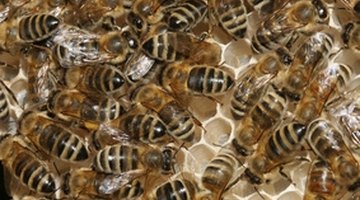How to Build a Cob House Floor
Building the floor of a cob house requires a slightly different technique than building the walls but can be done by almost anyone. Your cob home should be a comfortable haven--for many people, this means avoiding modern flooring techniques and materials. An earthen floor provides a warm, pleasant-feeling surface, even in bare feet. It can take a while to build, but it'll last for many years to come.
Making Cob

-
Determine the sand and clay percentages in your soil. Place a sample of the soil in a clear jar with enough water to create a liquid. Shake up the mixture and allow the jar to settle. Sand will form a layer on the bottom, followed by silt and clay layers. If your soil has a high percentage of clay, you will need to add sand for better malleability. If your soil has a high percentage of sand, you should add clay for greater stickiness.
-
Place sand, soil and clay onto a sturdy plastic tarp in the percentages from your jar test. You don't need to be extremely precise in your measurements, since cob is so forgiving. Lift one end of the tarp and pull it forward to begin the mixing process. Repeat this process until you have combined all ingredients. You can also mix with your hands and feet or use a shovel.
-
Add 10 to 40 percent straw to the mixed soils. Wet down the pile, and mix in water and straw to create a cob the consistency of sticky dough. It should form a loaf shape when the tarp is lifted but not be so dry it falls apart.
-
Add gravel or shillet. The base layer should be at least half crushed rock. Later layers should contain progressively less rock. The high gravel percentage prevents water from being trapped in the lower layers.
Floor
-
Lay out a quantity of high-rock cob mix over the entire floor. Begin at the corner farthest from the door and work toward the door. Tamp this mixture by hand or using a mechanical compactor. The first layer should be tamped strongly, until you can't compress it any more. Allow the floor to dry until just damp. This may require you to wait overnight.
-
Add the second layer. This layer can have a higher earth and sand percentage and does not need to be tamped as firmly. Apply enough pressure to create a layer that will not shift. Allow the floor to dry until damp.
-
Create the finish cob. Mix a fairly dry cob containing no stone, and use small pieces of straw, unless you like the look of straw on the surface. Wet the surface of the previous layer with a watering can.
-
Add the finish layer. Dump buckets of cob on the surface, starting in the far corner. Flatten the mix with your hands, then with a trowel. Press hard to create a smooth surface. The final layer should be between ½ inch and 2 inches thick. Use thinner layers in damp climates. Allow the floor to dry--this may take up to four weeks.
-
Patch cracks. As the cob floor dries, cracks may appear. Patch the cracks with finish cob and allow them to dry.
Finishing
-
Use a rag, roller, brush or sponge to apply a coat of boiled linseed oil to the entire floor. Apply the oil until it begins to puddle, then wipe off excess oil. Allow the linseed oil to cure.
-
Dilute boiled linseed oil with 25 percent turpentine, citrus thinner, mineral spirits or another solvent. Apply the oil as before, wipe off excess, and allow it to dry.
-
Repeat the oiling process with another coat of half oil and half solvent, and one of 25 percent oil and 75 percent solvent. Allow each layer to dry fully for a durable, water-resistant floor.
-
Melt 1 part beeswax with 2 parts linseed oil. Apply the warm paste to the floor with a clean, lint-free rag. Allow the paste to cure. The floor may need to be rewaxed every few months.
References
- "The Hand-Sculpted House"; Ianto Evans, Michael G. Smith, and Linda Smiley; 2002
- Weblife Cob Builders Handbook: Cob Floor Surface
Resources
Tips
- Add paint to the top layer of oil to provide color.
- Tamped cob can last for many years.
Warnings
- A tamped cob floor is labor-intensive.
- Never allow water to puddle on a cob floor.
Writer Bio
G.D. Palmer is a freelance writer and illustrator living in Milwaukee, Wis. She has been producing print and Web content for various organizations since 1998 and has been freelancing full-time since 2007. Palmer holds a Bachelor of Arts degree in writing and studio art from Beloit College in Beloit, Wis.
Photo Credits
- honigbienen als bauarbeiter image by Heinz Waldukat from Fotolia.com
More Articles



